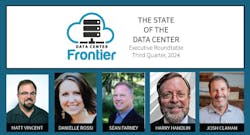The Data Center Frontier Executive Roundtable features insights from industry executives with lengthy experience in the data center industry. Here’s a look at the insights from Josh Claman, CEO of Accelsius.
Josh Claman is the CEO of Accelsius, makers of direct-to-chip, two-phase cooling technology. An advocate for the power of transformative technology throughout his 30-year career, Mr. Claman has grown and repositioned businesses at Dell, NCR and AT&T.
Here's the full text of Josh Claman's insights from our Executive Roundtable.
Data Center Frontier: What are the main considerations for the procurement and deployment of mechanical and electrical infrastructure in data center adaptive reuse projects and sites, versus for new construction? And to what degree are supply chain concerns presently a factor?
Josh Claman, Accelsius: We are now at a point where most data center operators understand that liquid cooling is the future. This leads to a lot of debate around how to make this transition in the most efficient way.
Let’s start with the simple math: as of December 2023, there are close to 11,000 data centers worldwide, nearly half of which reside in the United States.
Now, in the age of AI, regardless of how recently these data centers were built, most of them will need to be retrofitted with more modern and energy-efficient technology, and if they want to maintain operations, they’re going to need to be retrofitted fast.
The industry knows this. However, the common narrative is that liquid cooling can only be enabled in new builds. Retrofitting existing sites is going to be prohibitively expensive, much more so than constructing a new data center. It’s time to question this premise.
Consider the alternative. Consider the full cost of a new build—financial, sure, but also environmental.
The impact of concrete alone should give us pause when considering a greenfield project. Concrete represents up to 80% of a new data center’s embodied carbon emissions, and concrete itself annually represents 11% of total global emissions—more than the entirety of the EU’s carbon emissions.
With hyperscalers now backpedaling on their carbon-neutral goals, some even admitting their carbon emissions have risen substantially while pursuing AI, it’s time for the industry to radically innovate with an emphasis on sustainability—and it can start by focusing on existing infrastructure.
Yes, there may be stranded physical capacity, but retrofitting can be, in many cases, a more sustainable and practical answer than starting from scratch.
Of course, supply chain concerns are still a factor. We’re still hearing of very long lead times for almost all equipment involved in power conditioning and traditional air cooling as companies work through multi-year backlogs. This impacts both new builds and retrofits.
Data Center Frontier: How do you see service level agreements (SLAs) evolving for data center equipment and expansion projects in the age of rapidly escalating AI, HPC and cloud computing demand?
Josh Claman, Accelsius: With AI and large learning models, we frequently hear that it doesn’t really matter if there’s downtime.
No one talks about five-nines or other traditional IT metrics of availability when it comes to LLMs.
The problem, however, is that the assets you’ve deployed can’t sit idle–because, once idle, your ROI for those assets is now muted.
Sure, for inference engines, high-frequency trading and HPCs, we should aim for that 99.999% availability.
But for large learning models, the math needs to change.
You need to ensure those assets are fully utilized, which is why a lot of our clients move to liquid cooling.
They want to avoid the throttling events that occur with traditional air cooling.
Data Center Frontier: What are some key project management tips and strategies for facility operators and developers seeking to balance a need for great versatility with a mutual need for great specificity in data center designs for the AI era?
Josh Claman, Accelsius: First, when planning a project, you need to look ahead and guarantee you’ve got investment protection.
From a cooling perspective, one way to achieve this is by putting in facility infrastructure that can support multiple types of cooling technology, such as a facility water loop that can support single-phase direct-to-chip, two-phase direct-to-chip, and immersion.
Then, when choosing your cooling technologies, it’s smart to choose solutions that run at the highest possible FW temperature to drive sustainability and efficiency–that way, you won’t have to keep your chillers ramped up around the clock.
Overall, flexibility is key.
Of course, while we’re convinced that two-phase direct-to-chip cooling is the future of liquid cooling, it’s imperative to keep your options open to whatever the future may bring.
Data Center Frontier: What's the best path forward for innovation in data center infrastructure optimization, in terms of engineering for ongoing energy efficiency gains and maximum clean energy utilization in the face of AI's exponential power requirements?
Josh Claman, Accelsius: As an industry, we’re going to need to plan for rack densities of 200 to 300 kW, which means we’ll need to prepare for power conditioning that can deliver that level of power to individual racks.
Of course, that uptick in rack density means we’ll also need to think about water—mainly shifting from evaporative towers to a closed loop. This also probably necessitates a shift in the development of data centers away from hot, arid locations with scarce water and rapidly emptying aquifers towards more northern locations.
Finally, we see a positive change in the perspective of colocation providers.
Traditionally, these companies have been relatively glib about efficiency. They passed the cost of the inefficiency onto their clients.
However, we now sense a change – not only are colos focusing more on efficiency, but we also see them wanting to take more of a thought leadership role in power and cooling architectures.
It’s time to think beyond our industry.
We continue to hear of protests labeling data centers as “energy vampires.” Data center companies can no longer justify a new build with high PUEs or even higher water consumption to existing communities.
Whether we like it or not, our industry needs to get serious about sustainability. We need to make every watt count.
About the Author
Matt Vincent
A B2B technology journalist and editor with more than two decades of experience, Matt Vincent is Editor in Chief of Data Center Frontier.




